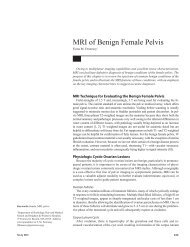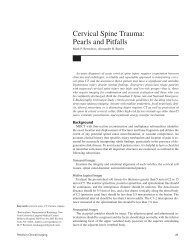Scientific Session 1 â Breast Imaging: Mammography
Scientific Session 1 â Breast Imaging: Mammography
Scientific Session 1 â Breast Imaging: Mammography
Create successful ePaper yourself
Turn your PDF publications into a flip-book with our unique Google optimized e-Paper software.
<strong>Scientific</strong> <strong>Session</strong> 9—Cardiopulmonary <strong>Imaging</strong>TuesdayResults: Our data showed that isolated pelvic VTE was present in only0.3% of all CTPA and CTLV (five of 1527). Isolated pelvic VTE was presentin 3.3% (5/151) of all CTLV showing evidence of VTE. There was nosignificant statistical difference in the detection of VTE that resulted fromthe inclusion or exclusion of the pelvis in the CTLV (p > 0.05).Conclusion: Pelvic imaging during CT PE protocol is not necessary forthe detection of VTE. The high radiation dose during CTLV is well documentedin the literature and is predominantly due to the radiation of thepelvis. The performance of CTLV without including the pelvis can decreasethe population radiation dose generated by CT usage.076. Is Pulmonary Embolism More Common in CertainMalignancies as Detected by CT Pulmonary Angiography?Malak, S. 1 ; Kohr, J. 1 *; Casey, M. 2 ; Ginsberg, M. 1 1. Memorial Sloan-Kettering Cancer Center, New York, NY; 2. Drexel University,Philadelphia, PAAddress correspondence to S. Malak (sharpmalak@gmail.com)Objective: To stratify the results of CT pulmonary angiograms (CTPAs) byspecific malignancy in patients with suspected pulmonary embolism (PE).Materials and Methods: The institutional review board approved thisretrospective study. We searched our hospital information system for allpatients at our tertiary cancer center undergoing evaluation for PE duringa 3-month study period. Per our institution’s standard reporting protocolall CTPAs are reported as one of four diagnostic descriptors: positive,negative, equivocal, or limited for PE. Results were stratified by primarymalignancy. Clinical symptoms and CTPA indications were collected.Clopper-Pearson binomial 95% CI was calculated for proportions.Results: Five hundred seventy-eight CTPAs were performed in 497 patientswith cancer (53.9% women, 46.1% men). Median patient age was62.6 years. The most frequent underlying cancers were lung (21.1%),gastrointestinal (20.5%), genitourinary (18.5%), and breast (15.9%).The highest proportion of positive CTPAs was in patients with genitourinarycancer, 14.8% (95% CI, 8.7–22.9%), followed by lung carcinoma,11.9% (95% CI, 6.8–18.9%), gastrointestinal cancer, 11.4%(95% CI, 6.2–18.7%), and breast cancer, 7.4% (95% CI, 3.0–14.6%).Clinical symptoms and previous central venous thrombus, active chemotherapy,and recent major operation were not significantly associatedwith a positive CTPA.Conclusion: The incidence of PE as detected by CTPA was highestamong patients with genitourinary cancer, lung carcinoma, gastrointestinalcarcinoma, and breast carcinoma.077. Is There an Impact on Diagnostic Quality of CT PulmonaryAngiograms With the Introduction of Bismuth <strong>Breast</strong> Shields?Kohr, J.*; Malak, S.; Ginsberg, M. Memorial Sloan-Kettering CancerCenter, New York, NYAddress correspondence to J. Kohr (kohrj@mskcc.org)Objective: To determine if the use of bismuth breast shields increasesthe frequency of limited studies of CT pulmonary angiography (CTPA).Materials and Methods: The institutional review board approved this retrospectivestudy. We searched our hospital information system for all femalepatients at our tertiary cancer center undergoing evaluation for pulmonaryembolism (PE) after the implementation of bismuth breast shields. Imageswere evaluated for the presence of breast shields after suggested implementation,and studies without shields were excluded from analysis. The CTPAprotocol was identical for both historical control and shielded groups. Ourinstitution’s standard reporting protocol requires all CTPA to be reported asone of four diagnostic descriptors: positive, negative, equivocal, or limitedfor PE. CTPA are considered limited if, due to technical or other factors,the assessment for PE cannot be determined to the level of subsegmentalbranches. Radiology reports were searched for these categories. Reportsfrom a historical control group prior to implementation of breast shieldswere used. The proportions of limited examinations for the historical controland shielded groups were calculated and compared using chi-square tests.Results: Two hundred thirty-nine women underwent 256 CTPA examinationswith breast shields in the first 4.5 months after implementation.Two hundred sixty-seven women underwent 287 CTPA examinationsduring a 3-month period prior to the implementation of shielding andserved as our historical control group. The proportion of limited studiesdid not significantly change after the implementation of breast shields(66/256 [25.8%] versus 61/287 [21.3%], p = 0.02).Conclusion: We found no significant impact on the proportion of diagnosticCTPA studies after the implementation of breast shields. Whilefurther studies are needed to confirm our results, we found no evidenceto suggest that breast shields have a clinically significant impact on diagnosticquality of CTPA studies.078. Sizing Up the Ascending Aorta With ECG-Gated CTA: AreBody Axes Sufficient?Atalay, M.*; Mitchell, C. Alpert Medical School, Brown University,Providence, RIAddress correspondence to M. Atalay (atalay_99@yahoo.com)Objective: Because of the natural curvature of the aortic root, measuringits diameter by CT angiography (CTA) is challenging with standardimaging planes. Accurate measurement typically requires postprocessingin multiple obliquities, which demands workstation expertise and can betime consuming. The study aims to determine the accuracy of measurementsmade on axial, coronal, sagittal, and sagittal oblique (SO) images.Materials and Methods: We conducted a review of 76 consecutive ECGgatedthoracic aorta CTA (TA-CTA) studies (34 men, 42 women; mean age± SD, 63 ± 15 years; mean heart rate ± SD, 63 ± 14 beats/min) and 76 consecutivecardiac CTA (CCTA) studies with reduced heart rate (36 men, 40women; mean age ± SD, 68 ± 13 years; mean heart rate ± SD, 58 ± 10 beats/min). Studies were performed on a 64-row MDCT scanner with 0.6-mm slicecollimation. Data were acquired during mid diastole. Studies were importedfrom PACS to a 3D workstation where measurements were made using axial,sagittal, coronal, and SO axes at four sites: annulus, sinuses of Valsalva (SoV),sinotubular junction (STJ), and midascending aorta (MA). Oblique short-axisviews were then obtained for optimal visualization of all measurement sites.Three measurements were made at the SoV (commissure to opposite cuspapex × 3) and two orthogonal measurements at the annulus, STJ, and MA.The average of these values at each site served as reference standard measurements.Mean ratios of all measurements relative to reference standard valueswere calculated at each measurement site for all four axes.A30*Will present paper
















